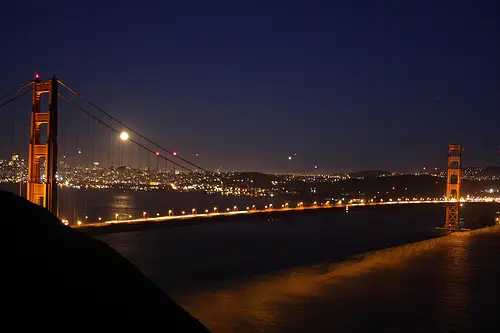With its classic, world-renowned beauty and spectacular setting, the San Francisco Bay's Golden Gate Bridge is a magnet for would-be suicides. The turbulent waters at its base, the Raccoon Strait, are feared by mariners, so success in killing oneself is virtually guaranteed.
The 67-metre fall from the bridge takes four seconds, and jumpers hit the water at 120 kilometres per hour. As of 2006, only 26 people are known to have survived the jump. The official suicide count ended in 1995, when the number approached 1,000. In the eight years preceding 2003, there was an average of one suicide jump every two weeks, which brought the unofficial total to more than 1,300 suicides.
In 1996, California Highway Patrol removed seventy apparently suicidal people from the bridge. Currently, it is said that a person jumps off the Golden Gate every 15 days, but not every suicide attempt is witnessed.Bridge-jumpers who do survive always strike the water feet first, and all suffer multiple internal injuries and broken bones. Sarah Rutledge Biennium may be the only person to have jumped twice. She survived the first jump in 1988, but died in her second attempt that year.
Bridge officials are at a loss to prevent suicides. In addition to erecting a barrier, signs along the span promote a special telephone on the bridge that connects to a crisis hot line. A plan to close the bridge at night was stymied.
Attempts to introduce a higher suicide barrier have been thwarted by engineering difficulties, high costs, and public opposition to tampering with the bridge's aesthetics.
"The Bridge" is a documentary film that captured 23 suicide jumps made from the Golden Gate in 2004.
The 67-metre fall from the bridge takes four seconds, and jumpers hit the water at 120 kilometres per hour. As of 2006, only 26 people are known to have survived the jump. The official suicide count ended in 1995, when the number approached 1,000. In the eight years preceding 2003, there was an average of one suicide jump every two weeks, which brought the unofficial total to more than 1,300 suicides.
In 1996, California Highway Patrol removed seventy apparently suicidal people from the bridge. Currently, it is said that a person jumps off the Golden Gate every 15 days, but not every suicide attempt is witnessed.Bridge-jumpers who do survive always strike the water feet first, and all suffer multiple internal injuries and broken bones. Sarah Rutledge Biennium may be the only person to have jumped twice. She survived the first jump in 1988, but died in her second attempt that year.
Bridge officials are at a loss to prevent suicides. In addition to erecting a barrier, signs along the span promote a special telephone on the bridge that connects to a crisis hot line. A plan to close the bridge at night was stymied.
Attempts to introduce a higher suicide barrier have been thwarted by engineering difficulties, high costs, and public opposition to tampering with the bridge's aesthetics.
"The Bridge" is a documentary film that captured 23 suicide jumps made from the Golden Gate in 2004.
